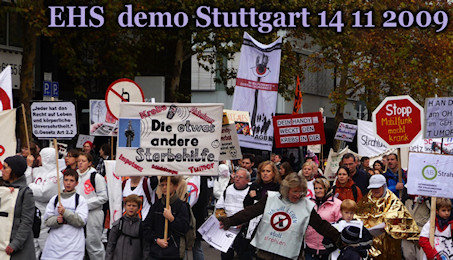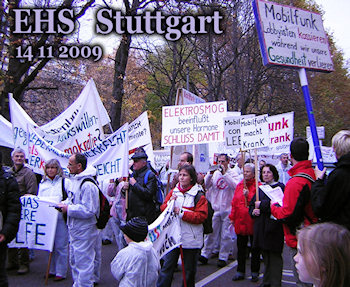 |
 |
|
 |
 |
About Us | Contact |
|
|
19/11/2009 - WiFi in Swindon - free access but at what cost?As recently covered by the BBC and the Times, Swindon Borough Council are offering a free public WiFi service to the entire of the town of Swindon. Offering high bandwidth, cheap services, this sounds like a technological boon for the residents of the town, but could it also be a public health experiment when so little is still understood about the potential health impacts of wireless technology? There are currently about 75 mobile phone base stations in Swindon. Swindon Borough Council are about to effectively increase this number 20-fold. Swindon Council have invested about one-third of a million pounds in a commercial venture to exploit the modern telecommunications boom. They plan to install some 1,400 WiFi Access Points (mini-base-stations) across the city, mainly on lamp-posts. That works out to about one every 100 metres in every direction thought the city. Many of these will be right outside bedroom windows.
The claimed advantage is that residents of Swindon can have a couple of hours free WiFi access throughout the city. Only time will tell exactly how useful this is. The Council claim that they will be able to offer connection speeds up to 20 Mbs. However, WiFi access points can usually only handle about 8 or so simultaneous users without significant data-bottlenecks and hold-ups, especially if people are watching videos or other using high bandwidth data streams. The speed then usually drops dramatically and you get video-freeze-ups and missing bits. So, it is likely that Swindon residents, who do much more than check their emails and browse a few Internet sites, will still need to subscribe to a proper broadband Internet service as well. The Council say that residents will be able to purchase more time on the WiFi network. However, WiFi networks are not designed for high user numbers and multiple high-bandwidth requirements and so this is unlikely to provide an adequate quality of service to such users. The downside is that Swindon will be flooded with an extra level of pulsing microwave signals. Officially, these do us no harm, but there is already considerable and mounting evidence that at least some people (5% or so seems a reasonable ballpark figure - see Table 10 in Neil Irvine's "HPA report" from 2005) experience adverse effects on their well-being. No study has been published on the health of people regularly exposed to WiFi signals. There have been over 10 published studies on the effects of similar pulsing microwave signals from mobile phone base stations. These show a range of adverse effects on the well-being of people living nearby. Top of the list are headaches, concentration and memory difficulties, chronic fatigue, sleep problems, depression, irritability and behavioural problems. Other reported effects include heart rhythm disruption and nosebleeds. As yet, none of these constitute some form of irrefutable proof, but both the similarity of the technology, exposure, and reported symptoms, leave WiFi as at least a plausible candidate with regards to the published science so far. As a result, some form of precautionary approach by avoiding exposure where it isn't necessary seems warranted. The literature is still hinting that levels of 0.6 V/m upwards, typical for those using the wirelessly enabled laptops measured by the HPA, may increase the risk of cancer [Wolf 2004,Eger 2004] and a number of other somatic neurological symptoms [Santini 2002,Santini 2003,Navarro 2003,Bortkiewicz 2004,Nikolova 2005,Yurekli 2006,Abdel-Rassoul 2007,Preece 2007,Augner 2008]. It is quite possible that these levels could be exceeded in many areas of Swindon from these new access points alone.
There are repeated claims, from both the industry and from misinformed technology enthusiasts, that WiFi uses only a few watts of energy, "less that a light bulb", and therefore can't do any harm. We need to understand the fact that light and microwaves used for communication have very different frequencies and signal shapes which result in them interacting with people in very different ways. We are not talking here about thermal effects and there is considerable evidence for concern at very low exposure levels. Many scientists, public health officials, MEPs and concerned citizens are now calling for a more precautionary and sensible approach with regards to wide scale adopting of wireless technology. The German Government's health protection agency recommends the public reduce their exposure to high frequency radiation to minimise health risks. It recommends the removal of cordless DECT phones, use cabled connections rather than WiFi and Bluetooth and site WiFi access points away from people, including at work. The Frankfurt City Government and Bavarian Parliament have recommended against the installation of WiFi in schools. This is becoming quite a political issue in Germany. The two pictures show a recent demonstration in Stuttgart against the spread of electrosmog that is increasingly adversely affecting many people. The Director of the European Environmental Agency (EEA), recently provided comments on public health implications of electromagnetic fields. Professor McGlade provided a set of recommendations and said "there is a need to reconsider the scientific basis for the present EMF exposure standards which have serious limitations such as reliance on the contested thermal effects paradigm; and simplistic assumptions about the complexities of radio frequency exposures." David Carpenter, MD, Director of the Institute for Health and the Environment, School of Public Health, University of Albany, New York, has said 'Based on the existing science, many public health experts believe it is possible we will face an epidemic of cancers in the future resulting from uncontrolled use of cell phones and increased population exposure to WiFi and other wireless devices. The French Agency for Environmental and Occupational Health Safety (Afsset) has just issued a new report, recommending that:
Please also read read our overview on WiFi and exposure levels and health. As part of the UK HPA EMF Discussion Group, we and a number of others in the group put together a WiFi memorandum to the Health Protection Agency about some study work that they were about to present. They have since reported their findings, which is all about measurements because they were told NOT to include anything on health effects (by the Health Minister). Research into the health of those actually exposed to WiFi is now urgently overdue, looking not into exposure levels but actual symptoms - even something along the lines of the Bamberg doctors work would give useful futher indications of a potential risk. We have also put together a feature piece in the Daily Mail on this issue. Links
Other important WiFi concerned organisations
References1. -
Irvine N et al, (November 2005) Definition, Epidemiology and Management of Electrical Sensitivity, HPA-RPD-010 [View Author's abstract conclusions]
2. P
Wolf R, Wolf D, (April 2004) Increased incidence of cancer near a cell-phone transmitter station, International Journal of Cancer Prevention, 1(2) April 2004 [View Author's abstract conclusions]
3. P
Eger H et al, (November 2004) The Influence of Being Physically Near to a Cell Phone Transmission Mast on the Incidence of Cancer, Umwelt Medizin Gesellschaft 17,4 2004 [View Author's abstract conclusions]
4. P
Santini R et al, (July 2002) Investigation on the health of people living near mobile telephone relay stations: I/Incidence according to distance and sex, Pathol Biol (Paris) 2002 Jul;50(6):369-73 [View Author's abstract conclusions] [View
on Pubmed]
5. P
Santini R et al, (September 2003) Symptoms experienced by people in vicinity of base stations: II/ Incidences of age, duration of exposure, location of subjects in relation to the antennas and other electromagnetic factors, Pathol Biol (Paris). 2003 Sep;51(7):412-5 [View Author's abstract conclusions] [View
on Pubmed]
6. P
Navarro EA et al, (December 2003) The Microwave Syndrome: A Preliminary Study in Spain, Electromagn Biol Med 22(2-3): 161-169 [View Author's abstract conclusions]
7. P
Bortkiewicz A et al, (2004) Subjective symptoms reported by people living in the vicinity of cellular phone base stations: review, Med Pr. 2004;55(4):345-51 [View Author's abstract conclusions] [View
on Pubmed]
8. P
Nikolova T et al, (October 2005) Electromagnetic fields affect transcript levels of apoptosis-related genes in embryonic stem cell-derived neural progenitor cells, FASEB J. 2005 Oct;19(12):1686-8 [View Author's abstract conclusions] [View
on Pubmed]
9. P
Yurekli A et al, (2006) GSM base station electromagnetic radiation and oxidative stress in rats, Electromagn Biol Med 25(3):177-88 [View Author's abstract conclusions] [View
on Pubmed]
10. P
Abdel-Rassoul G et al, (March 2007) Neurobehavioral effects among inhabitants around mobile phone base stations, Neurotoxicology. 2007 Mar;28(2):434-40 [View Author's abstract conclusions] [View
on Pubmed]
11. P
Preece AW et al, (June 2007) Health response of two communities to military antennae in Cyprus, Occup Environ Med. 2007 Jun;64(6):402-8 [View Author's abstract conclusions] [View
on Pubmed]
12. P
Augner C et al, (September 2008) GSM base stations: Short-term effects on well-being, Bioelectromagnetics. 2008 Sep 19. [Epub ahead of print] [View Author's abstract conclusions] [View
on Pubmed]
Also in the newsGerman protest march against wireless technologyNext-Up have published some stunning pictures from Germany showing the current strength of feeling in the country about wireless devices and the potential risk to health they may be bringing with them. There are clearly hundreds of protesters in these images, complete with flyers, banners, and custom made costomes. Their feelings were made very clear in this protest march in the city of Stuttgart in Germany. Read the full story on Next-Up. The latest on the REFLEX scandalFranz Adlkofer and Hugo W Rüdiger have struck back at the constant rumourings that some of their earlier REFLEX work was faked. Explaining a number of the background issues around the controversy, they make a strong case that the data was robust, that the MUV council's investigations into the data cleared them of wrong-doing, and that the scandal was raised simply to prevent higly controversial and potentially industry-damaging data from being published. Read the full response. South African medical practitioner appeals to WHO for more protectionKarl Muller, a journalist* and ex-physics lecturer* in South Africa who has strong concerns about the health effects of wireless technology, has written an "SOS" letter to Emilie Van Deventer of the World Health Organisation. Explaining how WHO policy virtually dictates all levels of guidance and precaution for the entire continent of Africa, he makes a number of very poignant points about how they are not being given suitable protection from the rapid proliferation of microwave emitting devices. He highlights a number of individual case examples that highlight the potential of a serious problem, and finishes with the following plea to the World Health Organisation that they take the situation seriously and investigate what is happening in South Africa: This is relevant to Africa as a whole, and it is a fact that South Africa is given responsibility by WHO for the whole of Africa with regard to RF protection -- ironic, since South Africa has no regulations in place, and does not lift a finger to protect its own citizens in this regard. With Africa's wide-open spaces, dispersed populations and lack of fixed-line infrastructure, we now have far more cellphones than landlines, and we are at the most risk of illness if there turns out to be a problem; and yet we have the least protection. So this is really a continent-wide problem, with yourselves as basically the sole authority on the landscape; and again, I appeal to you to take your responsibilities seriously, and come make a proper investigation on the ground as to what is happening here. What I have described is not even the tip of the iceberg. Note: * These descriptors were corrected on 2nd December 2009. Read the full letter. This page has links to content that requires a .pdf reader such as |



